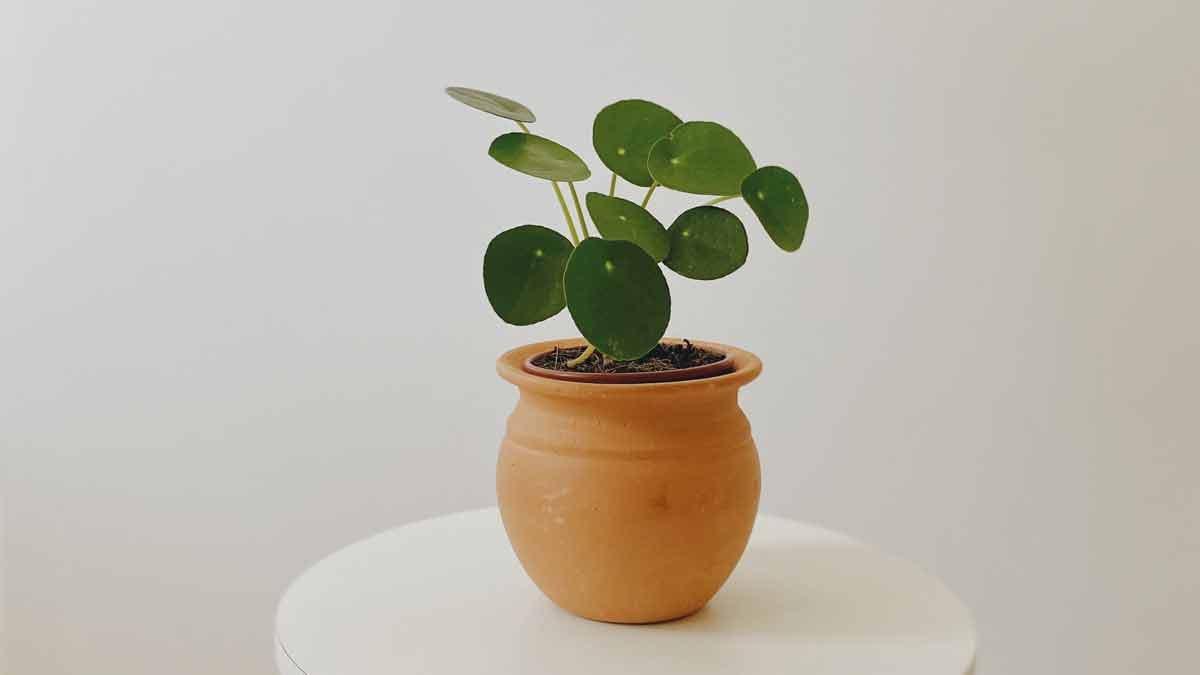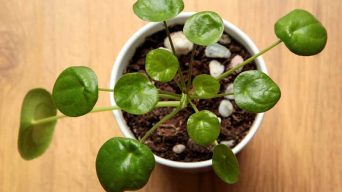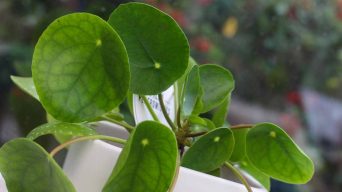If your Pilea is experiencing leaves falling off, it could be due to several environmental factors such as lack of light, improper temperature, pests, or overwatering. Check to make sure the plant is getting enough sunlight, and the soil is not too wet. Be sure to also check for pests and adjust the temperature accordingly. Keep an eye on your Pilea and make adjustments as needed.
Pilea plants, also known as the Chinese money plant, are known for their easy care and ability to thrive indoors.
However, even the most low-maintenance plant can experience problems from time to time.
One common issue pilea owners face is leaves falling off the plant.
This article will explore why pilea leaves may fall off and some solutions to fix the problem.
What Causes Pilea Leaves to Fall Off
There are several reasons why pilea leaves may fall off the plant.
The most common reasons are:
1. Overwatering
Overwatering is one of the most common reasons pilea leaves fall off.
Pileas are native to tropical regions and do not like to sit in wet soil.
If the soil is constantly wet, it can cause the roots to rot, eventually killing the plant.
If you think your pilea is being overwatered, the first step is to check the soil.
If it is wet or soggy, allow the top inch of the soil to dry out before watering again.
You can also try using a well-draining potting mix to help prevent overwatering.
2. Underwatering
Underwatering is another common reason for pilea leaves to fall off.
Pileas must be watered at least once a week and more often during the hot summer.
If the pilea plant is underwatered, the leaves will turn yellow and eventually fall off.
To fix this problem, ensure you water your pilea regularly and give it enough water each time.
The best way to tell if a pilea plant needs water is to feel the soil.
If it is dry to the touch, it is time to water.
3. Temperature Stress
Pileas are tropical plants and prefer warm, humid conditions.
If the temperature drops too low or the air is too dry, it can cause the leaves to fall off.
Pilea plants thrive in temperatures between 60-80 degrees Fahrenheit.
If the temperature drops below 60 degrees, you may need to move your plant to a warmer location.
If the temperature rises above 80 degrees, you may need to provide extra humidity for your plant.
One way to do this is to place the pot on a tray of pebbles and water.
As the water evaporates, it will help raise the plant’s humidity.
4. Nutrient Deficiency
A nutrient deficiency is another common reason for pilea leaves to fall off.
Pileas need a balanced fertilizer to stay healthy.
If the plant is not getting enough nutrients, it will show signs of distress, such as yellowing or wilting leaves.
To fix this problem, fertilize your pilea monthly during the growing season.
Use a balanced fertilizer and follow the instructions on the package.
5. Pest Infestation
Pests are another common problem that can cause pilea leaves to fall off.
Common pests that attack pileas include aphids, spider mites, and mealybugs.
These nuisances extract nutrients from the plant, leading to the potential yellowing of leaves and their eventual detachment.
Start spraying your plant with a water hose to remove any visible pests to get rid of pests.
Then, treat the plant with insecticidal soap or neem oil.
To use insecticidal soap, mix 1 teaspoon of soap with 1 quart of water and spray the plant.
To use neem oil, mix 2-3 teaspoons of oil with 1 quart of water and spray the plant.
Make sure to follow the instructions on whichever product you use.
6. Fungal Diseases
Fungal diseases are another common issue that can cause pilea leaves to fall off.
Common fungal diseases include powdery mildew, black spot, and leaf spot.
These diseases are caused by too much moisture and can be challenging to control.
To prevent fungal diseases, ensure your plant has good drainage and is not overwatered.
You can treat the plant with a fungicide if it gets a disease.
You can use a natural fungicide made from baking soda and water or buy a commercial fungicide.
Mix 1 teaspoon of baking soda with 1 quart of water to make the baking soda fungicide.
Spray the plant every 7-10 days until the disease is gone.
7. Lack of Light
Pileas need bright, indirect light to grow properly.
If the plant is not getting enough light, the pilea will start to get leggy, and the leaves will fall off.
To fix this problem, move your plant to a brighter location.
The best place for a pilea is near an east- or west-facing window.
If you can’t provide enough light with natural light, you can supplement with grow lights.
8. Too Much Sunlight
While pileas need bright light to grow, they can’t tolerate direct sun.
If the plant is in direct sunlight, the leaves will start to burn and eventually fall off.
To fix this problem, move your plant to a place where it will only get indirect light.
The best place for a pilea is near an east- or west-facing window.
9. Poor Soil Quality
Pileas need well-draining, loose potting soil to grow correctly.
If the soil is too dense, it will hold onto too much water, and the roots will rot.
This can cause the leaves to fall off.
To fix this problem, repot your pilea in a well-draining potting mix.
You can also add some perlite or sand to the potting mix to improve drainage.
Make sure the pot has drainage holes so the water can drain out.
10. Repotting Shock
Repotting shock is another common reason for pilea leaves to fall off.
When you repot a plant, it can be stressful for the plant and cause the leaves to drop.
To avoid this, repot your pilea in the spring when it is actively growing.
Use a well-draining potting mix and a pot slightly larger than the current one.
Place the plant in a bright, indirect light location and water it as needed.
The leaves should start to grow back within a few weeks.
11. Natural Leaf Drop
Pileas are known for their natural leaf drop.
In the wild, pileas drop their leaves in the winter to conserve energy.
They will grow new leaves in the spring when the weather warms up.
If your pilea drops its leaves in the winter, there’s nothing to worry about.
Just keep the plant in a cool location and water it when the soil dries out.
The leaves should start to grow back in the spring.
How To Prevent Pilea Leaves From Falling Off
Now that you know why pilea leaves fall off, you can take steps to prevent it.
Here are some tips for preventing pilea leaves from falling off:
- Water the plant when the top inch of soil is dry
- Fertilize the plant once a month during the spring and summer
- Make sure the plant has good drainage
- Repot the plant in the spring every year or two
- Keep the plant in a bright, indirect light location
- Avoid direct sunlight, which can burn the leaves
- Avoid drafts, which can cause the leaves to drop
- Place the plant in a room with a consistent temperature
- Prune the plant regularly to remove dead or dying leaves
These tips can prevent pilea leaves from falling off and keep your plant healthy and happy.
What Are The Benefits of Pilea Leaves Falling Off?
Pilea leaves falling off is a common occurrence. While it may seem like a problem, this process has several benefits.
For one, pilea leaves falling off helps the plant to get rid of old, damaged, or sick leaves. This allows the plant to focus its energy on new growth, which is healthier overall.
In addition, pilea leaves falling off can help to encourage new growth. When old leaves fall off, the plant has more space to produce new ones. This can help to keep your pilea looking full and healthy.
So, don’t be alarmed if you notice your pilea leaves falling off. This is a natural process that can be beneficial for the plant.
What To Do With The Pilea Leaves That Fall Off
If you want to, you can save the pilea leaves that fall off and use them to propagate new plants. This is a great way to get free plants!
Although propagating pilea plants from leaves isn’t the most straightforward method, it is possible.
But for this to work, the fallen leaf must have a stem attached. If the leaf has already detached from the stem, it won’t be able to propagate a new plant.
To propagate pilea plants from leaves, place the leaf in a jar of water. Ensure that the stem is submerged and there are no air bubbles.
Then, place the jar in a spot with indirect sunlight and wait for new roots to grow. Once the roots are a few inches long, you can pot the plant in the soil.
If you don’t want to propagate new plants, you can compost the pilea leaves that fall off. This is a great way to recycle and return them to the earth.
Final Thoughts
As you can see, there are a few reasons your pilea may be dropping leaves.
But don’t worry; with some extra care, you can get your plant back to good health in no time.
Be sure to check your pilea regularly for pests, water it when the soil is dry, and give it bright, indirect light.
With some love, your pilea will look as good as new in no time!







